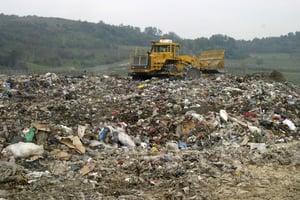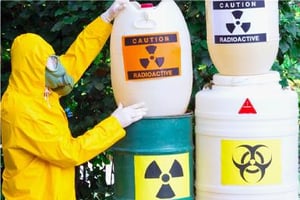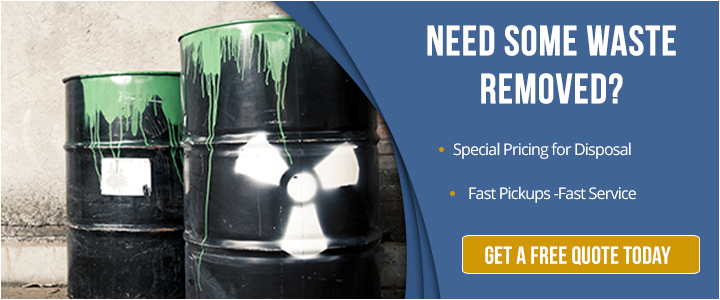If you are a business and generate hazardous waste, you are responsible for managing all aspects of that waste, including disposal.
Large companies typically work with commercial hazardous waste disposal services to safely and legally remove the waste from their facilities and transport it to the appropriate treatment, storage and disposal facility (TSDF).
For smaller companies, what they must do with the hazardous waste they generate gets a little murkier since states have different requirements based on how much waste is produced. That distinction often determines whether drop off or pick up are the options you have available to you.
Eligibility For Drop-Off Facilities
In California, hazardous waste collection facilities are available for the general public to drop off hazardous waste items, from electronic waste to products used for cleaning that, when improperly disposed of, could harm the environment.
off hazardous waste items, from electronic waste to products used for cleaning that, when improperly disposed of, could harm the environment.
However, there are different, more stringent regulations in place for businesses that often produce greater quantities of hazardous waste. If you own a small business and generate very little hazardous waste, the good news is that you may have the option of utilizing drop-off site services.
In California, you may qualify as a Conditionally Exempt Small Quantity Generator (CESQG) in which you would be permitted to use a Household Hazardous Waste (HHW) facility. State regulations define a business as a CESQG if it generates less than:
- 27 gallons or 220 pounds of hazardous waste per month, or
- 1 quart or 2.2 pounds of acutely hazardous waste per month
If your business generates hazardous waste in excess of these regulatory limits, you cannot use HHW facilities. This law is designed to help small businesses, non-profit organizations and other entities that may have small amounts of hazardous waste that they need to dispose of, but want or need to avoid the costs of hiring a commercial hazardous waste transportation company.
To determine if you qualify for this exemption, you will need to:
- Calculate how much hazardous waste you generate each month
- Obtain a California EPA ID number
- Choose an HHW facility
It’s important to keep in mind that HHW facilities have their own sets of rules and policies you must follow. Some only accept certain types of waste, and some facilities require that the waste be generated in the county where the HHW facility exists. Many cities and counties will list the types of waste their HHW facilities accept on their government websites.
If You Don’t Qualify For HHW Facilities
If your business is in an industry known for generating hazardous waste (manufacturing, laboratories, medical, pharmaceutical, construction, printing, transportation and more), you won’t likely qualify for HHW facilities.
Instead, you will need to take your waste to the proper TSDF. However, this is likely not something you can accomplish alone using your own resources.
State law limits the total amount of hazardous waste your business can transport to the CESQG numbers outlined above: 27 gallons or 220 pounds per month. Furthermore, no individual container may be more than 5 gallons or 50 pounds.
If your business generates more than 27 gallons or 220 pounds per month, the only individuals who may transport your hazardous waste are those who hold a valid registration. The Department of Toxic Substances Control (DTSC) must issue this registration.
This law applies to both those classified as small hazardous waste generators and large hazardous waste generators. However, it is important to note that the more hazardous waste you generate, the more stringent your disposal and transportation requirements will be.
In California, a large quantity generator (LQG) is an entity that generates 1,000 kg or more of hazardous waste per month, excluding universal wastes and/or more than 1 kg of acutely or extremely hazardous waste per month.
A small quantity generator (SQG) generates less than 1,000 kg of hazardous waste per month, excluding universal wastes, and/or 1 kg or less of acutely or extremely hazardous waste per month.
Both small quantity generators and large quantity generators generally rely on the services of hazardous waste disposal companies in order to comply with cradle to grave requirements. Cradle to grave states that a hazardous waste generator is responsible for its waste from its initial generation through disposal.
What To Look For In A Waste Disposal Company
Hazardous waste disposal is an important component of your business. Improper disposal practices can have long- term implications for your company, which is why it’s essential to work with a trusted hazardous waste transporter and disposal company.
term implications for your company, which is why it’s essential to work with a trusted hazardous waste transporter and disposal company.
While budget is a concern for most purchases, when it comes to choosing a disposal vendor, it’s often not the best course of action to go with the least expensive one. Don’t trade short-term cost savings for long-term liabilities.
The best disposal company will:
- Identify wastes through sampling and testing
- Transport the wastes to recycling and disposal sites
- Prepare labels, manifests and other paperwork
- Offer prompt pickups
- Address any cost concerns you have
- Assist you with packaging your waste so that you can avoid fines and save money
- Offer a walk-through program to help you identify any potential problems or cost-savings measures
The best hazardous waste disposal pick up services are familiar with all aspects of state and federal regulations, including how they define large vs. small hazardous waste generators. This is important because a company’s waste generator status is measured on a monthly basis and companies can change the category from month to month based upon workflow and changes in production.
If you’re misclassified, you could be wasting money putting processes in place to meet more stringent requirements. Or the opposite could occur and you could face steep fines for not meeting the appropriate regulations.
Make sure the hazardous waste disposal company that you work with is licensed and regulated as well. Check the California Department of Toxic Substances Control’s Registered Hazardous Waste Transporters Database for access to this information.
While California has some of the highest numbers of hazardous waste regulations, an experienced disposal company can help you navigate them, ensuring you are properly set up to meet these laws and reduce your liability.


Comment